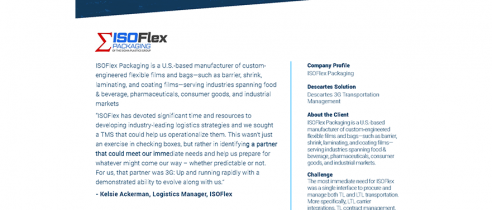Blog
Looking for Carrier Capacity? Look for a Transportation Management System.

In June, FedEx Freight announced it would suspend service for more than 1,400 of its shipper customers — obviously a major and sudden disruption to those shippers’ distribution channels that left them scrambling to procure new transportation, and likely at a rate well above the rate they’d agreed to with FedEx.
FedEx’s reason isn’t surprising: Their capacity and network are maxed out. They didn’t have a choice. They’ve seen daily volumes climb by about 30% over the past year, and their fleet, their terminals, and their docks can only handle so much.
FedEx is far from the only LTL carrier facing a critical capacity crunch and turning away freight and customers. The market is so tight it’s bordering on a crisis for the transportation network itself.

In addition to the surging and shifting demand we’ve seen in the market, carriers simply haven’t been able to grow their capacity. It’s expensive (tens of millions if not billions of dollars) to build out and operate a larger LTL network. And it takes time. It can’t be done overnight or even in the course of a few months.
Also, many carriers simply don’t have the appetite to expand and potentially become overleveraged in this volatile market. Especially when it comes to spending resources finding trucks and drivers to build their network with other capital investments in place.
LTL carriers are simply tired of the economic yo-yo effect they’re often navigating. And that’s long been how carriers have operated — scaling up when they need capacity, then suddenly finding themselves overleveraged and overexposed when demand slips.
When a carrier is at capacity, it has to find a way to handle the volume it can manage. FedEx’s solution last month was to cut back on customers. That’s one way to do it. And it’s likely something we’ll see more and more of, unfortunately.
These LTL capacity issues aren’t going anywhere soon. The only answer for shippers to manage their transportation is to turn to dynamic solutions and to lean on technology that has and is rapidly evolving to meet the shifting needs of the supply chain and transportation network.
A few major shifts are likely on the horizon for how shippers, carriers, and brokers interact — and they’re all predicated on the idea of dynamic transportation management systems (TMS) and integrations of those platforms by each party involved in a freight transaction.
Here are a few examples:
Dynamic Pricing
Like we’ve seen with surge pricing in ride pooling services like Uber and Lyft, we could see the same types of pricing systems come to the LTL market (and other trucking sectors), all routed through integrated TMS platforms and based on the current market dynamics of supply (available carrier capacity) and demand (the amount of freight in the system).
In all liklihood, carriers will view surge pricing as a necessity to regulate capacity. They don’t have a choice since scaling up and down simply isn’t an option (or a realistic solution). To maximize their revenue, they will find other ways to accommodate shippers rather than turning them away.
The dynamic pricing model certainly needs to be on shippers’ radars as a likely looming shift.
Menu Options for Shippers
Shippers running a dynamic TMS system integrated with their carrier and broker networks will have the ability to simply browse through their TMS to find the right options for any given shipment. Or, ideally, their TMS would do this for them. That doesn’t just mean finding the right price and per-mile rates — it means dynamically shopping each shipment for mode shifts (such as LTL to parcel or intermodal, for example), rates, and available capacity.
So, if your freight fell out of the FedEx network, for example, your TMS would simply select the next-best option from your carrier pool, even if that means a necessary mode shift, a multi-truck approach, or channeling it to a third-party logistics provider.
Keith Bassuener, logistics manager at Beamis Manufacturing Company, put it this way recently: “We needed to be able to take full advantage of the work we’ve done to provide a good carrier base and good rates. We’d been manually routing our freight and the number of iterations to accomplish pool consolidation. But we knew we were leaving money on the table. We needed a TMS to help us automate the planning, plus take into account data points like fuel surcharges and intermodal rates, which have become extremely important in recent years.”
Most carriers understand this trend as one of the paths forward, and they realize the need to adopt platforms that can integrate with shipper platforms via simple APIs. If carriers have a platform that can connect via API, then utilizing this type of dynamic mode, price, and capacity shopping is simple as flipping a switch.
If your carriers don’t have these types of capabilities yet, start bringing them on board.
A significant point of consideration here, too, is that TMS platforms no longer take months and months to implement. Historically, that’s long been a major headache and pain point for shippers, brokers, and carriers. However, it’s no longer the case. Modern TMS systems take weeks to set up and, since they’re cloud-based, pricing is based on usage and not exorbitant monthly member-type fees.
Becoming a Broker or Setting Up Your Own Fleet
Having trouble hiring capacity in the market? Well, why not simply build your own dedicated capacity? That’s a trend we’ve seen return for many shippers — either leasing a private fleet to supplement their for-hire program or setting up a small fleet of their own.
Intertwined with that trend is shippers then having the ability to become a broker. Why not broker out your excess capacity when there is some? Or on the flip side, you could use your brokerage to find capacity, even if you don’t have trucks. These are dynamic solutions to the current environment, and they demand a dynamic TMS.
What’s happening now in the market, and the likely path forward is for all parties to become more dynamic and agile. How that ultimately evolves, no one can say, truthfully. The one thing that should be clear is that we all need to be more flexible, agile, and willing to find those dynamic solutions.
Think a Transportation Management System Can Help with Carrier Capacity?
Read our article about conquering supply chain uncertainty with the right TMS for more insights on what a TMS like 3G’s can do for you.







